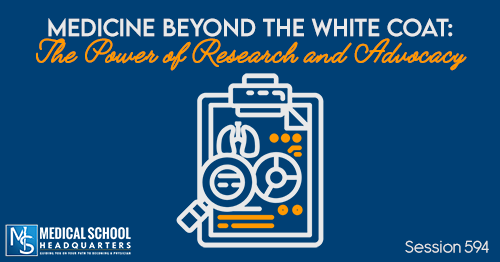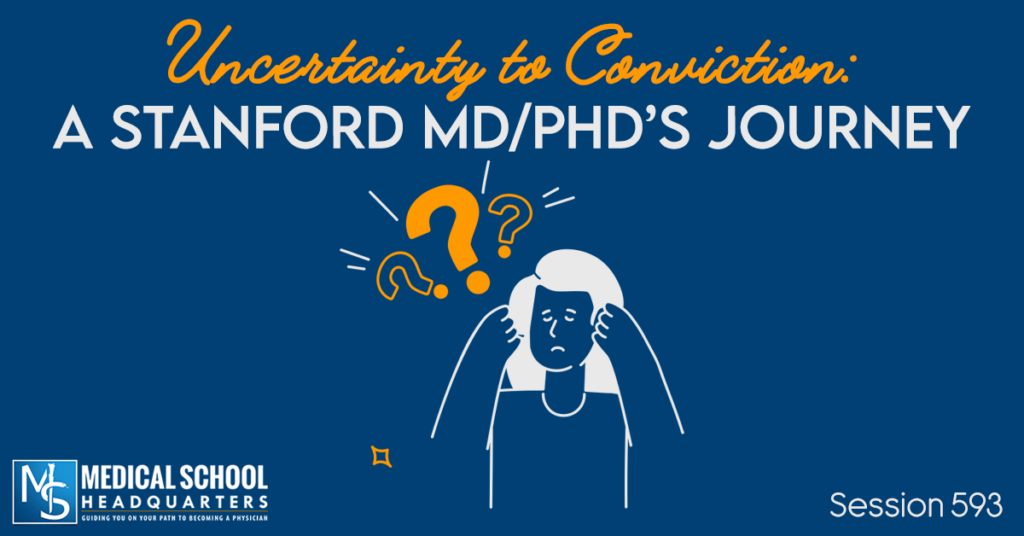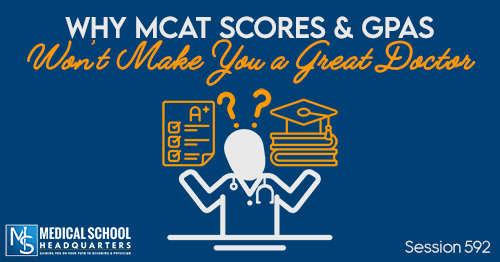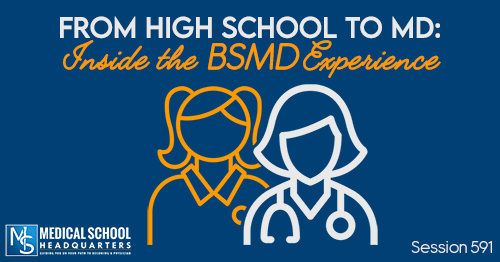Medical terminology hits you like a brick wall when you start medical school. Suddenly you’re expected to be able to say and spell words like “keratoconjunctivits” or “leukoencephalopathy.”
While learning the intricacies of medical terminology is important, today I just want to touch on some of the jargon you may hear about medical school itself along this path. Here is my collection of medical school jargon every premed and medical student should know.
Types of Medical Schools
- Allopathic: An allopathic physician holds an MD degree. The majority of medical schools are allopathic degree schools.
- Osteopathic: An osteopathic physician holds a DO degree. Osteopathic medicine has only been around since 1892. The core curriculum is very similar to MD schools, with some different philosophy in the teaching. DOs also learn OMT, osteopathic manipulation therapy.
[Related episode: Let’s Talk About Osteopathic Docs and What You Need to Know.]
Organizations
- AAMC: Association of American Medical Colleges. Represents allopathic medical schools.
- AACOM: American Association of Colleges of Osteopathic Medicine. Represents osteopathic medical schools.
- AMSA: American Medical Student Association. Student-governed organization for medical students.
- AMA: American Medical Association. The professional society for physicians.
- NBME: National Board of Medical Examiners. The organization that evaluates allopathic medical students and residents through the USMLE exam and Shelf Exams.
- NBOME: National Board of Osteopathic Medical Examiners. The organization that evaluates osteopathic medical students and residents through the COMLEX exam and Shelf Exams.
Application Services
- AMCAS: American Medical College Application Service. The application used to apply to most MD schools. Read more about the AMCAS application.
- AACOMAS: American Association of Colleges of Osteopathic Medicine Application Service. The application used to apply to DO schools.
- TMDSAS: Texas Medical and Dental School Application Service. The application service for Texas Medical schools.
- ERAS: Electronic Residency Application Service. The application service used to apply for residency, also known as the Match.
Tests
- MCAT: The Medical College Admission Test. This is the test to get into any medical school.
- Shelf Exam: Specific subject examinations after 3rd- or 4th-year rotations offered by the NBME and NBOME.
- USMLE Step Exams: United States Medical Licensing Exam. Series of 3 tests prior to medical licensure for allopathic medical school graduates. Osteopathic medical school graduates can also take the USMLE if they wish to go to an allopathic residency.
- USMLE Step 2 is broken down into Step 2CK for Clinical Knowledge (computer-based exam) and Step 2CS for Clinical Skills (in-person live exam and history-taking of standardized patients).
- COMLEX Level Exams: Comprehensive Osteopathic Medical Licensing Examination. Series of 3 tests prior to medical licensure for osteopathic medical students. These are the osteopathic equivalents to the USMLE Step exams.
Training Years
- MS1-4: This is how most medical students refer to themselves. MS for medical student, and then 1-4 depending on your year. You will sign most of your notes this way: “John Doe, MS3.”
- Sub-I: Sub-Internship. Done during your 3rd and 4th years of medical school, your Sub-I is typically an audition rotation for where you hope to attend residency.
- Internship: The first year of residency. See our tips for internship.
- Categorical Intern: Doing your internship as part of a full residency program.
- Prelim Intern: Doing your internship separately from your main residency program.
- Transitional Intern: Doing your internship separately from your main residency program. Transitional programs have a mix of internal medicine and surgery.
- Residency: The 3-7 years after you graduate medical school where you learn the specifics of the specialty you choose. Residents are physicians. In some states, you can work as a physician only with the internship training of 1 year.
- Chief Resident: An honor held for the best residents in a program in their last year. These positions are typically voted upon by faculty and residents.
- PGY1-7: PGY stands for Post Graduate Year. Your PGY1 year is your internship. Technically, you can be a PGY40 since any physician is a PGY, but it is typically just referred to while you are still in training.
- Fellowship: Specialized training received after residency. Fellowships can be very specialized training like cardiology or gastroenterology, which are fellowships after an internal medicine residency. Fellowship training may also just expose you to more of something specific, like hand surgery or reconstructive surgery, which are both fellowships after an orthopedic surgery residency.
- Board Certification: After residency and fellowship, you must take a test to be able to call yourself board certified. These tests typically need to be retaken every 10 years.
- Attending Physician: You’re the boss! You’re done with all of your postgraduate training.
Miscellaneous
- Rounds (Rounding): When the team, typically lead by a senior resident or attending physician goes through the patient list to discuss each patient and what the plan is. This is typically done bedside but can also be done as “sitting rounds.”
- Pimping: “PIMP” is an acronym for “Put In My Place.” It’s when someone with more knowledge (an attending physician or senior resident) asks questions of someone with less knowledge (a medical student) to test their level of understanding, typically in a setting among peers. This can be humiliating and can be seen as part of the dark side of medical training, but it does help you learn the material and know what is important.
Links and Other Resources
- Check out my Premed Playbook series of books (available on Amazon), with installments on the personal statement, the medical school interview, and the MCAT.
- Related episode: How Premeds Aren’t Prepared for Medical School.
- Related episode: What Do the First Two Years of Medical School Look Like?
- Need MCAT Prep? Save on tutoring, classes, and full-length practice tests by using promo code “MSHQ” at Blueprint MCAT (formerly Next Step Test Prep)!







